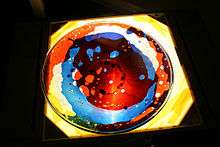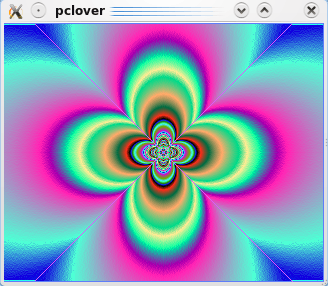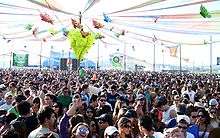Psychedelia
| Part of a series on |
| Psychedelia |
|---|
|


Psychedelia is a name given to the subculture of people, originating in the 1960s, who often use psychedelic drugs such as LSD, mescaline and peyote. The term is also used to describe a style of psychedelic artwork and psychedelic music. Psychedelic art and music typically try to recreate or reflect the experience of altered consciousness. Psychedelic art uses highly distorted and surreal visuals, bright colors and full spectrums and animation (including cartoons) to evoke and convey to a viewer or listener the artist's experience while using such drugs, or to enhance the experience of a user of these drugs. Psychedelic music uses distorted electric guitar, Indian music elements such as the sitar, electronic effects, sound effects and reverberation, and elaborate studio effects, such as playing tapes backwards or panning the music from one side to another. The term "psychedelic" is derived from the Ancient Greek words psychē (ψυχή, "soul") and dēloun (δηλοῦν, "to make visible, to reveal"),[1] translating to "soul-revealing".
A psychedelic experience is characterized by the striking perception of aspects of one's mind previously unknown, or by the creative exuberance of the mind liberated from its ostensibly ordinary fetters. Psychedelic states are an array of experiences including changes of perception such as hallucinations, synesthesia, altered states of awareness or focused consciousness, variation in thought patterns, trance or hypnotic states, mystical states, and other mind alterations. These processes can lead some people to experience changes in mental operation defining their self-identity (whether in momentary acuity or chronic development) different enough from their previous normal state that it can excite feelings of newly formed understanding such as revelation, enlightenment, confusion, and psychosis.
Psychedelic states may be elicited by various techniques, such as meditation, sensory stimulation[2] or deprivation, and most commonly by the use of psychedelic substances. When these psychoactive substances are used for religious, shamanic, or spiritual purposes, they are termed entheogens.
Etymology

The term was first coined as a noun in 1956 by psychiatrist Humphry Osmond as an alternative descriptor for hallucinogenic drugs in the context of psychedelic psychotherapy.[3] Seeking a name for the experience induced by LSD, Osmond contacted Aldous Huxley, a personal acquaintance and advocate for the therapeutic use of the substance. Huxley coined the term "phanerothyme," from the Greek terms for "manifest" (φανερός) and "spirit" (θύμος). In a letter to Osmond, he wrote:
To make this mundane world sublime,
Take half a gram of phanerothyme
To which Osmond responded:
To fathom Hell or soar angelic,
Just take a pinch of psychedelic[4]
It was on this term that Osmond eventually settled, because it was "clear, euphonious and uncontaminated by other associations."[5] This mongrel spelling of the word 'psychedelic' was loathed by American ethnobotanist Richard Evans Schultes, but championed by Timothy Leary, who thought it sounded better.[6] Due to the expanded use of the term "psychedelic" in pop culture and a perceived incorrect verbal formulation, Carl A.P. Ruck, Jeremy Bigwood, Danny Staples, Jonathan Ott, and R. Gordon Wasson proposed the term "entheogen" to describe the religious or spiritual experience produced by such substances.[7]
History
Timothy Leary was a well-known proponent of the use of psychedelics, as was Aldous Huxley. However, both advanced widely different opinions on the broad use of psychedelics by state and civil society. Leary promulgated the idea of such substances as a panacea, while Huxley suggested that only the cultural and intellectual elite should partake of entheogens systematically.
In the mid-1960s the use of psychedelic drugs became widespread in modern Western culture, particularly in the United States and Britain. The movement is credited to Michael Hollingshead who arrived in America from London in 1965. He was sent to the U.S. by other members of the psychedelic movement to get their ideas exposure.[8] The Summer of Love of 1967 and the resultant popularization of the hippie culture to the mainstream popularized psychedelia in the minds of popular culture, where it remained dominant through the 1970s. Resurgences of the style are common in the modern era.
Modern usage
The impact of psychedelic drugs on western culture in the 1960s led to semantic drift in the use of the word "psychedelic", and it is now frequently used to describe anything with abstract decoration of multiple bright colours, similar to those seen in drug-induced hallucinations. In objection to this new meaning, and to what some consider pejorative meanings of other synonyms such as "hallucinogen" and "psychotomimetic", the term "entheogen" was proposed and is seeing increasing use. However, many consider the term "entheogen" best reserved for religious and spiritual usage, such as certain Native American churches do with the peyote sacrament, and "psychedelic" left to describe those who are using these drugs for recreation, psychotherapy, physical healing, or creative problem solving. In science, hallucinogen remains the standard term.[9]
Visual art
Advances in printing and photographic technology in the 1960s saw the traditional lithography printing techniques rapidly superseded by the offset printing system. This and other technical and industrial innovations gave young artists access to exciting new graphic techniques and media, including photographic and mixed media collage, metallic foils, and vivid new fluorescent "DayGlo" inks. This enabled them to explore innovative new illustrative styles including highly distorted visuals, cartoons, and lurid colors and full spectrums to evoke a sense of altered consciousness; many works also featured idiosyncratic and complex new fonts and lettering styles (most notably in the work of San Francisco-based poster artist Rick Griffin). Many artists in the late 1960s and early 1970s attempted to illustrate the psychedelic experience in paintings, drawings, illustrations, and other forms of graphic design.
The counterculture music scene frequently used psychedelic designs on posters during the Summer of Love, leading to a popularization of the style. The most productive and influential centre of psychedelic art in the late 1960s was San Francisco; a scene driven in large measure by the patronage of the popular local music venues of the day like the Avalon Ballroom and Bill Graham's Fillmore West, which regularly commissioned young local artists like Robert Crumb, Stanley Mouse, Rick Griffin and others. They produced a wealth of distinctive psychedelic promotional posters and handbills for concerts that featured emerging psychedelic bands like Big Brother and the Holding Company, The Grateful Dead and Jefferson Airplane. Many of these works are now regarded as classics of the poster genre, and original items by these artists command high prices on the collector market today. Peter Max's psychedelic poster designs helped popularize brightly colored spectrums widely, especially among college students.
One example of this experimentation is seen in Mati Klarwein's painting Annunciation, which was used as the cover art for Santana's Abraxas (1970), and Klarwein's art was also used for the cover of the landmark "electric" jazz album Bitches Brew by Miles Davis (1970). The cover of Pink Floyd's album A Saucerful of Secrets (1968), is notable as an example of the psychedelic collage style, featuring visual elements from numerous print sources, which were combined photographically; it is also notable as one of the first major works by leading UK design house Hipgnosis, whose distinctive output exerted a powerful influence on album cover design for decades to come and includes some of the most famous rock albums covers of all time.
Contemporary with the burgeoning San Francisco scene, a smaller but equally creative psychedelic art movement emerged in London, led by expatriate Australian pop artist Martin Sharp, who created many striking psychedelic posters and illustrations for the influential underground publication Oz magazine, as well as the famous album covers for the Cream albums Disraeli Gears and Wheels of Fire. Other prominent London practitioners of the style included:
- design duo Hapshash and the Coloured Coat, whose work included numerous famous posters, as well as psychedelic "makeovers" on a piano for Paul McCartney and a car for doomed Guinness heir Tara Browne, and
- design collective The Fool, who created clothes and album art for several leading UK bands including The Beatles, Cream, and The Move. painted psychedelic designs on musical instruments for John Lennon and Cream, created psychedelic murals for the Surrey home of Beatle George Harrison, and designed the famous psychedelic mural on the facade of the short-lived Apple Boutique in Baker St, London.
The trend also extended to motor vehicles. The earliest, and perhaps most famous of all psychedelic vehicles was the the famous "Further" bus, driven by Ken Kesey and The Merry Pranksters, which was painted inside and out in 1964 with bold psychedelic designs (although these were executed in primary colours, since the DayGlo colours that soon became de rigueur were then not widely available). Another very famous example is the Rolls Royce owned by John Lennon - originally black, he had it repainted in 1967 in a vivid psychedelic gypsy caravan style, prompting bandmate George Harrison to have his Mini Cooper similarly repainted with logos and devices that reflected his burgeoning interest in Indian spirituality. Other notable examples include several cars re-painted in psychedelic style by Hapshash & The Coloured Coat, and the famous psychedelic Porsche owned by American singer Janis Joplin.

The Beatles' album cover for The Magical Mystery Tour album has features common in psychedelic art, such as a wide color palette and surreal visuals. Although primarily known for his work in the pop art genre, British artist Peter Blake created one of the defining works of psychedelic album art with his 1967 photographed mixed-media assemblage for the front cover of The Beatles' landmark 1967 album Sgt. Pepper's Lonely Hearts Club Band. The Beatles were also indirectly associated with another work now widely regarded as one of the pinnacles of psychedelic visual art, the lavish animated feature film Yellow Submarine (1968).
Examples frequently recur in the modern era. The cover of Oasis' album, Dig Out Your Soul (2008), has a psychedelic album cover, with a slightly muted color scheme.[10] In the modern era, computer graphics may be used to produce psychedelic effects for artwork.
Music
The fashion for psychedelic drugs gave its name to the style of psychedelia, a term describing a category of rock music known as psychedelic rock, as well as visual art, fashion, and culture that is associated originally with the high 1960s, hippies, and the Haight-Ashbury neighborhood of San Francisco, California.[11] It often used new recording techniques and effects while drawing on Eastern sources such as the ragas and drones of Indian music.
One of the first uses of the word in the music scene of this time was in the 1964 recording of "Hesitation Blues" by folk group the Holy Modal Rounders.[12] The term was introduced to rock music and popularized by the 13th Floor Elevators 1966 album The Psychedelic Sounds of the 13th Floor Elevators.[12] Psychedelia truly took off in 1967 with the Summer of Love and, although associated with San Francisco, the style soon spread across the US, and worldwide.[13]
The counterculture of the 1960s had a strong influence on the popular culture of the early 1970s. It later became linked to a style of electronic dance music, or rave music, commonly known as psychedelic trance.
Festivals

A psychedelic festival is a gathering that promotes psychedelic music and art in an effort to unite participants in a communal psychedelic experience.[14] Psychedelic festivals have been described as "temporary communities reproduced via personal and collective acts of transgression...through the routine expenditure of excess energy, and through self-sacrifice in acts of abandonment involving ecstatic dancing often fuelled by chemical cocktails."[14] These festivals often emphasize the ideals of peace, love, unity, and respect.[14] Notable psychedelic festivals include the biennial Boom Festival in Portugal,[14] as well as Nevada's Burning Man[15] and California's Symbiosis Gathering in the United States.[16]
Conferences
In recent years there has been a resurgence in interest in psychedelic research and a growing number of conferences now take place across the globe. The psychedelic research charity Breaking Convention have hosted one of the worlds largest since 2011. A biennial conference in London, UK, Breaking Convention: a multidisciplinary conference on psychedelic consciousness[17] is a multidisciplinary conference on psychedelic consciousness. In the US MAPS held their first Psychedelic Science conference,[18] devoted specifically to research of psychedelics in scientific and medical fields, in 2013.
See also
- Counterculture of the 1960s
- Ego death
- Erowid
- God in a Pill?
- Psychedelic era
- Psychedelic fish
- Psychedelic literature
- Psychedelic plants
- Serotonergic psychedelic
- Timeline of 1960s counterculture
References
- ↑ "psychedelic". Online Etymology Dictionary.
- ↑ Psychedelic sensory stimulation exemplified by "The Holotope Experience" utilized by Bashar. Explained in YT video titled "About The Holotope Experience".
- ↑ Nicholas Murray, Aldous Huxley: A Biography, 419.
- ↑ Janice Hopkins Tanne. "Humphry Osmond". BMJ: British Medical Journal. 328 (7441): 713. doi:10.1136/bmj.328.7441.713. PMC 381240
 .
. - ↑ Martin, Douglas (2004-02-22). "Humphry Osmond, 86, Who Sought Medicinal Value in Psychedelic Drugs, Dies". New York Times. Retrieved 4 December 2010.
- ↑ W. Davis (1996), One River: Explorations and Discoveries in the Amazon Rain Forest. New York, Simon & Schuster, Inc. p. 120
- ↑ R. Gordon Wasson, Albert Hofmann, and Carl A.P. Ruck, The Road to Eleusis: Unveiling the Secret of the Mysteries (North Atlantic Books, 2008), pgs. 138-139
- ↑ Wilson, Andrew (2007). "Spontaneous Underground: An Introduction to Psychedelic Scenes, 1965-1968". In Christopher Grunenberg, Jonathan Harris. Summer of Love: Psychedelic Art, Social Crisis and Counterculture in the 1960s (8 ed.). Liverpool: Liverpool University Press. pp. 63–98.
- ↑ "Drugs World". Informationisbeautiful.net. Retrieved 2011-10-19.
- ↑ "Oasis go psychedelic". BBC. 2007-10-29. Retrieved 2009-04-13.
- ↑ M. Campbell, Popular Music in America: And the Beat Goes on (Boston, MA: Cengage Learning, 3rd edn., 2008), ISBN 0-495-50530-7, pp. 212-3.
- 1 2 M. Hicks, Sixties Rock: Garage, Psychedelic, and Other Satisfactions (Chicago IL: University of Illinois Press, 2000), ISBN 0-252-06915-3, pp. 59-60.
- ↑ V. Bogdanov, C. Woodstra and S. T. Erlewine, All Music Guide to Rock: the Definitive Guide to Rock, Pop, and Soul (Milwaukee, WI: Backbeat Books, 3rd edn., 2002), ISBN 0-87930-653-X, pp. 1322-3.
- 1 2 3 4 St John, Graham. "Neotrance and the Psychedelic Festival." Dancecult: Journal of Electronic Dance Music Culture, Vol 1, No 1 (2009). Accessed on July 22, 2011.
- ↑ Griffith, Martin. "Psychedelic Festival to Attract 24,000 Fans", The Albany Herald, September 1, 2001. Accessed on July 22, 2011 from Google News Archive.
- ↑ Querner, Pascal (2010-07-28). "Capturing the Vision at California's Symbiosis Festival". Dancecult: Journal of Electronic Dance Music Culture. 1 (2). ISSN 1947-5403.
- ↑ "Breaking Convention: A Multidisciplinary Conference on Psychedelic Consciousness", Breaking Convention 2015 Retrieved 10-08-2016
- ↑ "Psychedelic Science", Multidisciplinary Association for Psychedelic Studies: MAPS Retrieved 10-08-2016
External links
| Look up psychedelic in Wiktionary, the free dictionary. |
| Look up psychedelia in Wiktionary, the free dictionary. |
| Wikimedia Commons has media related to Psychedelia. |
- Erowid
- Science & Consciousness Review, The Neurochemistry of Psychedelic Experience
- Psychedelic History
- Online archive: Religion and Psychoactive Sacraments
- Magic Mushrooms and Reindeer - Weird Nature. A short video on the use of Amanita muscaria mushrooms by the Sami people and their reindeer produced by the BBC.
